When the Earth Expanded (Part 3)
As this is all a work in progress, we can now revisit some previous considerations and review the exact mechanisms of the process.
The information discussed in Parts 1 and 2 will now be revisited, so please read these sections if you desire to understand the line of reasoning of this analysis.
For reference:

Wikipedia Creative Commons

The new global lithological map database GLiM: A representation of rock properties at the Earth surface by Jens Hartmann and Nils Moosdorf
In Part 2, the mixed sedimentary rock was looked at as representative of where the flood occurred. However, so far, it has been interpreted that the water originated at the hole formed in the Earth at what would become the western Pacific Ocean. However, many anomalies exist in such an analysis that are able to be further explained through the inclusion of mixed sedimentary rock locations.
For instance, if the flow originated from the Pacific Ocean, and then went across Asia and then northern Africa, then crossed the Americas where it ran into the mountain chains of North America, then why were the sands deposited into Africa only to be fertile soil of the Americas?
Indeed, the Pacific Ocean is where the Earth drastically erupted. However, with closer analysis, we can see more precisely what occurred. In the western Pacific Ocean, where this eruption is imprinted, the oldest ocean floor is considered to be 200 million years old.
Considered older still, however, is the seafloor along the continental crust between North America and Africa, considered 260 million years of age.
And the oldest region of them all is that of the Mediterranean Sea, considered to be 340 million years of age.
Importantly, there is no older ocean floor that has recycled. The age of the ocean floor shows the sequence of where the Earth expansion process occurred. And so, when the Earth ruptured, it did so forming the Mediterranean.
The fracture then went westward, but with a southward bend it physically compressed the land on the northern half of the fracture of Europe and North America producing the Alps and the Appalachian Mountains in the process. As we saw in the waves of Indonesia curling at the end, so too do the Alps have a curling structure.
The fracture ran through until the Straits of Gibraltar where it then curved down the coast of Africa. The fracture then went west between North America and South America--still intact with Africa. Notably, the dotted regions of the fracture shown above were not yet formed.
And when it entered the Pacific Ocean, the crack forming in the Earth was making its way to the south pole.
When it reached it, the weak point in the crust then ruptured, causing shockwaves of energy to rip into the Pacific Ocean as the crust erupted and produced the oceanic floor of the western Pacific Ocean.
From there, the Earth's remaining fractures were produced and the sea floor as we see it was produced.
This means that when the Earth initially fractured, it released a mixture of many things that, over the course of their travel, separated out and left behind only sand to be deposited in the deserts, while the Americas were flooded with fertile nutrients that, over its course of travel to Asia, became more separated out. As the water traveled along the newly formed Rocky Mountains, caused by the Earth's fracturing uplifting them from the eruption of the Earth causing the Western Pacific oceanic crust, it then continued out into Asia unabated, gathering physical mass as more waters accumulated, and it physically pressed into the Earth with its weight and forward motion, causing a wave of mountains to be formed.
This further explains the angle of the arc of the Himalayas, whereas water from the Pacific Ocean would not have traveled at quite the angle, without deflection, necessary to produce the Himalayas. Moreover, it explains why the whole Earth is not covered in similar formations.
On Atlantis
Tales of Atlantis, where it existed at the Strait of Gibraltar, further are within this process.
The Earth's expansion occurred and, among other things, brought the fall of Atlantis.
While we have very little to go by regarding Atlantis, the evidence strongly supports the likely existence of such a place at the Straits of Gibraltar.
Which is now on the eastern coast of North America. Flemish Cap.
Interestingly, if the Earth fractured at the Mediterranean and ran westward, curving down between Africa and North America, the energy released specifically as the fracture turned at Atlantis would have been quite devastating indeed. Not only would general processes have been experienced there, but a brunt force slap to the face where the energy targeted the region. As the process began, so came the fall of Atlantis.




